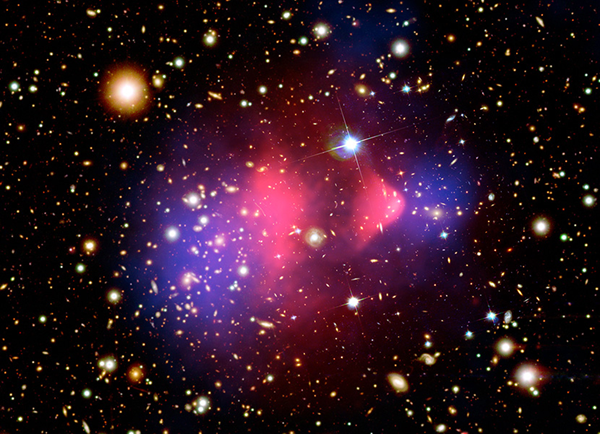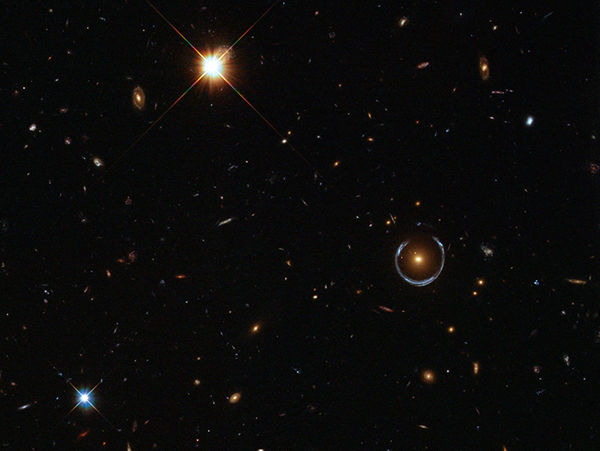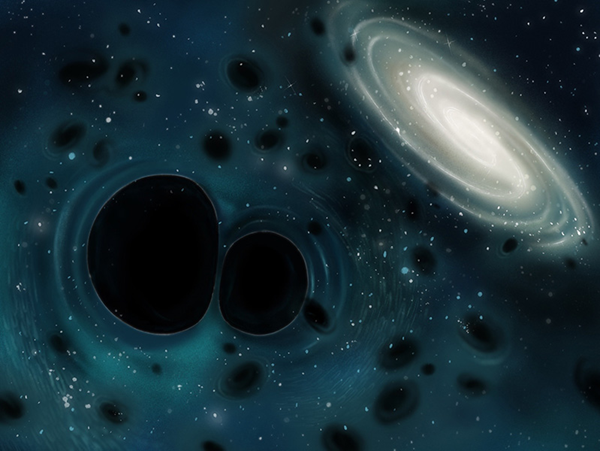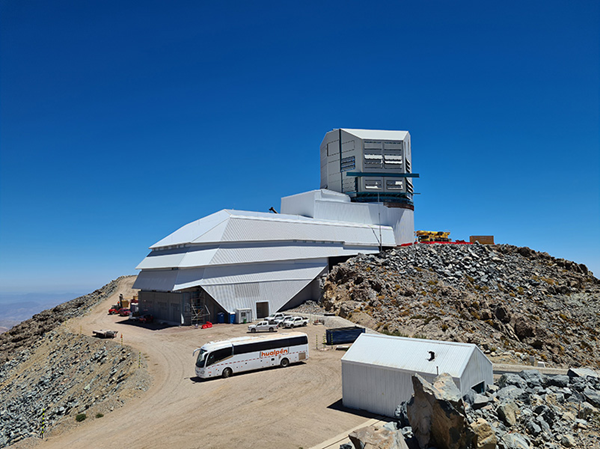“The first thought in everybody’s mind was, ‘What? This can’t be. This is impossible!’” recalls Kovetz, a physicist at Ben-Gurion University in Israel and a visiting scholar at Johns Hopkins. But then a more exciting suspicion began to creep in. Maybe, they thought, this could be a sign of primordial black holes.
Black holes from the dawn of time! It sounds like the title of a sci-fi B movie, but fractions of a second after our universe was born, a swarm of ravenous black holes could have spontaneously formed from the fiery energy permeating the cosmos. Supported by math and theory but never definitively observed, these primordial black holes are a possibility that has fascinated physicists for nearly half a century, gaining or losing popularity as new observations seemed to support or exclude their existence.
The puzzling 2015 signals from the US observatory, known as LIGO (Laser Interferometer Gravitational-Wave Observatory), and dozens more detections by the observatory and its European counterpart, Virgo, have fueled a surge of renewed interest in the idea, with hundreds of papers published on them in just the last five years.
Primordial black holes, if they exist, would be massive entities that give off no light, rendering them invisible. Since they would be scattered throughout the universe, they could help make sense of a wide variety of strange observations that have so far defied explanation. One of the main reasons researchers are drawn to these odd black holes is that they could solve one of the biggest, most vexing mysteries in astrophysics: the identity of dark matter.
Even though they can’t spot it, physicists know dark matter exists because its gravitational effects are seen all over the cosmos. But what it’s made of, nobody knows. Massive primordial black holes could be the long sought answer. Such large, heavy objects might also have served as the anchors around which early galaxies coalesced, another conundrum that has long resisted explanation.
Though skepticism remains, true believers are eagerly anticipating new telescope projects and sky surveys that might finally usher these captivating beasts from the sphere of speculation into the realm of reality.
Of MACHOs and WIMPs
Ordinary black holes arise from death. When a large star reaches the end of its life, it explodes in a spectacular supernova. The heavy core of the star, which can weigh at least a few times the sun’s mass, collapses down to form a compact object that is so dense even light cannot escape its gravitational pull. A black hole is born.
In the 1970s, luminary physicist Stephen Hawking and his PhD student Bernard Carr proposed another possible creation channel for black holes. It was known that shortly after the big bang, the universe was filled with a thick soup of radiation and fundamental particles like quarks and gluons, the building blocks of protons and neutrons. Natural density variations in the soup would have left some regions with more material and some with less. Hawking and Carr’s equations showed that areas with enough radiation and particles packed into them could have collapsed in on themselves and formed black holes with a wide range of possible sizes.
This idea was shelved, but then dusted off in the 1990s as the debate about what might make up dark matter began heating up. The enigmatic substance had been spotted gravitationally tugging on stars and galaxies and causing them to spin much faster than expected. Observations suggest that this invisible dark matter is so pervasive that it outweighs the matter we can see by more than five to one in the cosmos.
One camp favored the explanation that dark matter was made of compact objects including black holes — with a great deal of primordial ones from the beginning of time to help account for the extensive amount of dark matter — which were given the acronym Massive Astrophysical Compact Halo Objects (MACHOs). Rival scientists preferred the prospect known as Weakly Interactive Massive Particles (WIMPs), heretofore undetected subatomic particles that could exert a gravitational pull while remaining invisible.
But some researchers never completely gave up hope on some role for black holes in dark matter. That includes Carr, now at Queen Mary University of London in the UK, who coauthored a recent paper about primordial black holes in the Annual Review of Nuclear and Particle Science. “Primordial black holes are the ideal candidates,” he says. “We do know that black holes exist. You’re not invoking some particle for which we currently have no evidence.”
Bumps in the night
During the intervening decades, the hunt for WIMPs has so far come up empty-handed, though not for lack of trying. Enormous detectors dedicated to uncovering their existence have seen zilch. And the powerful particle-accelerating Large Hadron Collider near Geneva has found no indication of unexpected new subatomic entities. Consequently, some researchers had already been moving away from the WIMP idea when the new LIGO signals were detected, sparking rumors and shifting attention back to the black hole MACHOs.
The signals LIGO detected in 2015 were confirmed to be chirps from an enormous collision between two black holes, each weighing around 30 solar masses. The objects were oddly bulky — so large that if they had been created by collapsing stars, those stars would have had masses as high as 100 times that of our sun. Beasts that big should be fairly rare in the universe, Kovetz says, so LIGO either got lucky with its very first detection and spotted a very unusual event, or there are more giant black holes than physicists would expect if collapsing stars were the only origin. After the finding was announced the following year, three different teams proposed that these objects had been born not from stars but rather at the dawn of time before stars existed.
“When I wrote this paper … I fully expected someone would come up with some reason why it definitely couldn’t be true,” says Simeon Bird, a cosmologist at the University of California, Riverside, whose article, coauthored with Kovetz and others, was the first out of the gate. Instead, LIGO continued to capture additional signals from other black holes in this immense-mass range, setting off an excited flurry of activity among theoretical physicists that has yet to abate.
The models also suggest that over the course of cosmic history these various primordial black holes could have found one another. Pulled by gravity, the black holes could have formed clusters, with multiple smaller objects zipping around a central giant black hole, much as electrons are often drawn orbiting an atomic nucleus.
This could explain why MACHO hunters of the ’90s never saw enough objects to account for dark matter: They were only looking for gravitational lenses created by the smaller types of black holes. The lenses of smaller objects would be more compact and, as these float about the galaxy, they would take less than a year to pass in front of stars, causing their light to brighten and then dim relatively quickly. If black holes were found in clusters, the much larger gravitational warp in spacetime would take longer to pass in front of a distant star — multiple years or even decades.
Galaxy quest
Around 15 seconds after the big bang, one more type of black hole might have emerged. According to current calculations, these black holes would weigh a million times the mass of the sun, big enough to potentially explain the origin of galaxies.
Telescopes have spotted fairly well-developed galaxies at great distances, meaning they formed quite early in cosmic history. It’s puzzling, since galaxies are enormous structures and, at least in computer simulations, they take a long time to build up from the slow and plodding swirls of gas and dust found throughout the cosmos. But this is the best explanation for their formation that astronomers have come up with so far.
Primordial black holes may provide an easier route. Given that nearly all galaxies contain a huge black hole at the center, it seems possible these gravitational goliaths acted as starting points, helping to draw material into the earliest proto-galaxies quite early in cosmic history. As the universe progressed, these smallish galaxies would have become gravitationally attracted to one another, and then crashed and merged into the much larger galaxies seen today.
Carr and his colleagues have begun considering the possibility that primordial black holes may be far more widespread than anyone suspected. In theory, conditions shortly after the big bang might have also produced even smaller, planetary-scale black holes with masses roughly 10 times that of Earth. Surveys have in fact spotted tiny gravitational lenses floating throughout the galaxy, seen passing in front of stars and causing their light to rapidly flicker. Most astrophysicists have attributed these lenses to large, wandering planets that were ejected from their parent star systems. But not everyone agrees.
That includes theoretical physicist Juan García-Bellido of the Autonomous University of Madrid, who claims the lenses are caused by primordial black holes. A coauthor on Carr’s recent paper, García-Bellido remains quite gung-ho about the idea of primordial black holes.
In regard to dark matter, the theoretical models of the early universe also require a great deal of tweaking to get them to spit out the right number of black holes to match the amount of dark matter we know is out there. “It turns out to be quite difficult to come up with models that make the right amount of black holes,” Green says.
Even some of the bigger fans of primordial black holes are no longer as optimistic about the prospect that the types of black holes detected by LIGO could account for all dark matter in the universe. If many of those black holes were lurking throughout space, astronomers would have seen more of their effects by now, Kovetz says. He still thinks that they may contribute some and, more generally, that including more sizes of primordial black holes beyond what LIGO has detected could add up to enough to explain dark matter. And yet, “personally, I’ve lost some of my motivation.”
The good news is that new instruments may be able to help physicists get to the bottom of the question very soon. LIGO and Virgo are currently being upgraded and have now been joined by a Japanese gravitational wave detector named KAGRA. An Indian instrument will also turn on in the next few years.
Observations from these facilities may finally tip the scales one way or the other. Should the observatories spot a small black hole with one solar mass or less — something impossible to create from stellar evolution — it would provide exciting and definitive evidence of at least one type of primordial black hole, making them a much more appealing explanation for dark matter and galaxy formation.
In addition to looking for very small black holes, scientists could also seal the deal by finding black holes that formed before stars even existed. This may be beyond the capability of the existing observatories, but the European Space Agency is planning to launch a new, highly sensitive space probe called the Laser Interferometer Space Antenna (LISA) in the 2030s, which may be up to the task.
García-Bellido and others are planning to use yet another new instrument slated to start operations in 2023, the Vera C. Rubin Observatory in Chile, to hunt for stars that brighten over multiyear timescales, which could be evidence of clusters of black holes drifting amid the heavens. At least a few researchers expect that in three or four years’ time, they might finally have an actual, definitive answer to whether primordial black holes exist or not.
Until then, scientists will be sitting on the edge of their seats, trying to keep an open mind about dark matter. Perhaps the mysterious substance will turn out to be made of many things, including both exotic particles and black holes. “The universe is messy, and it has a lot of stuff in it,” says Bird. “I kind of believe that the universe likes to make things hard for physicists.”
This story was originally published with Knowable magazine. Read the original here.














